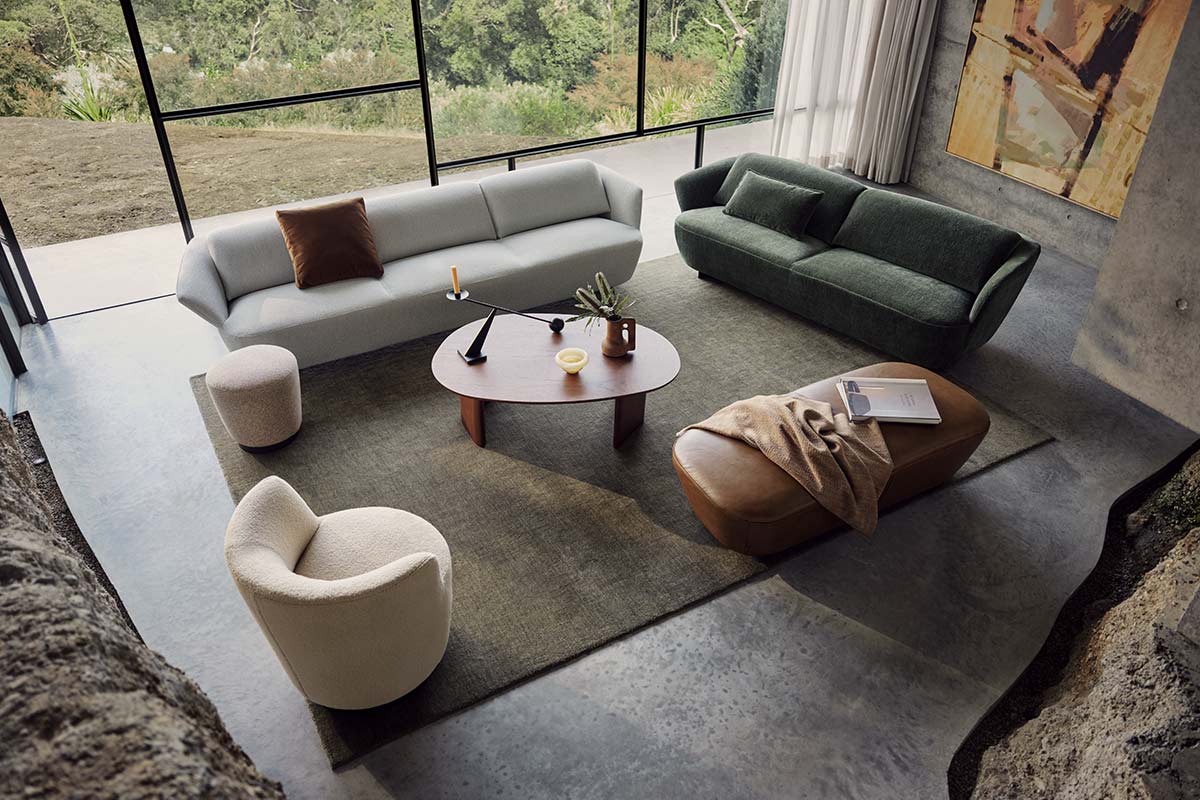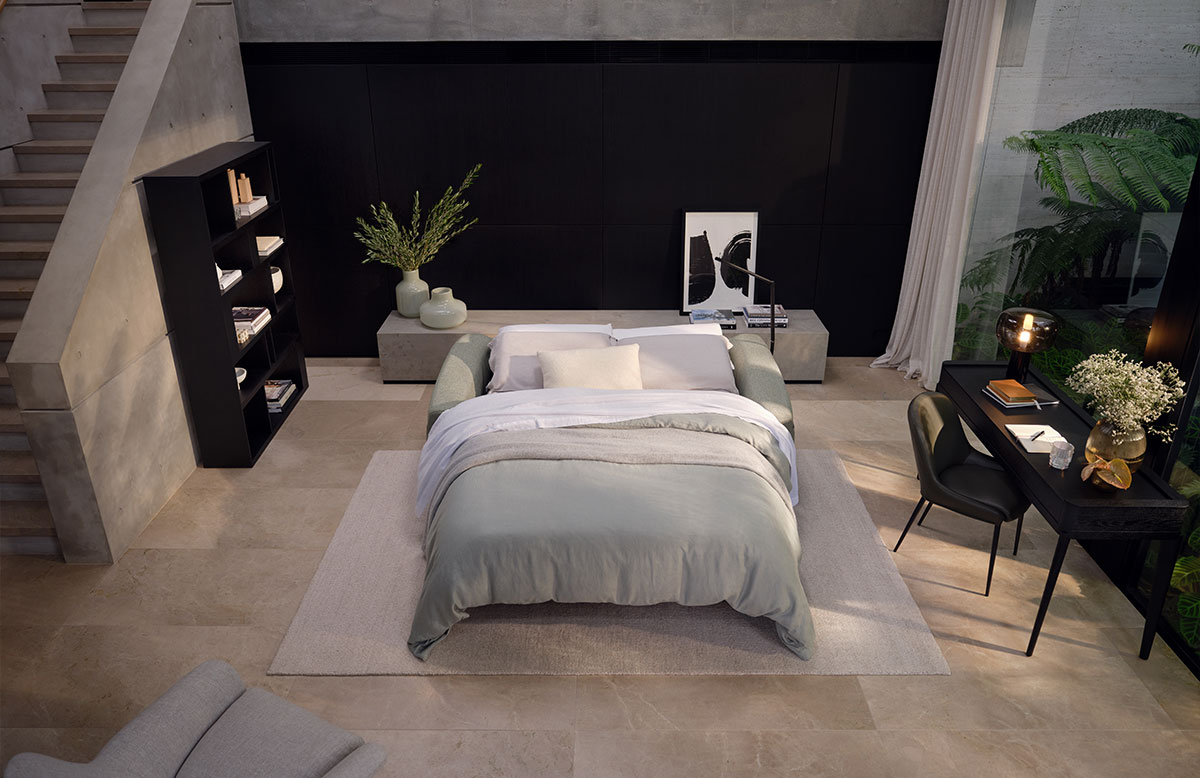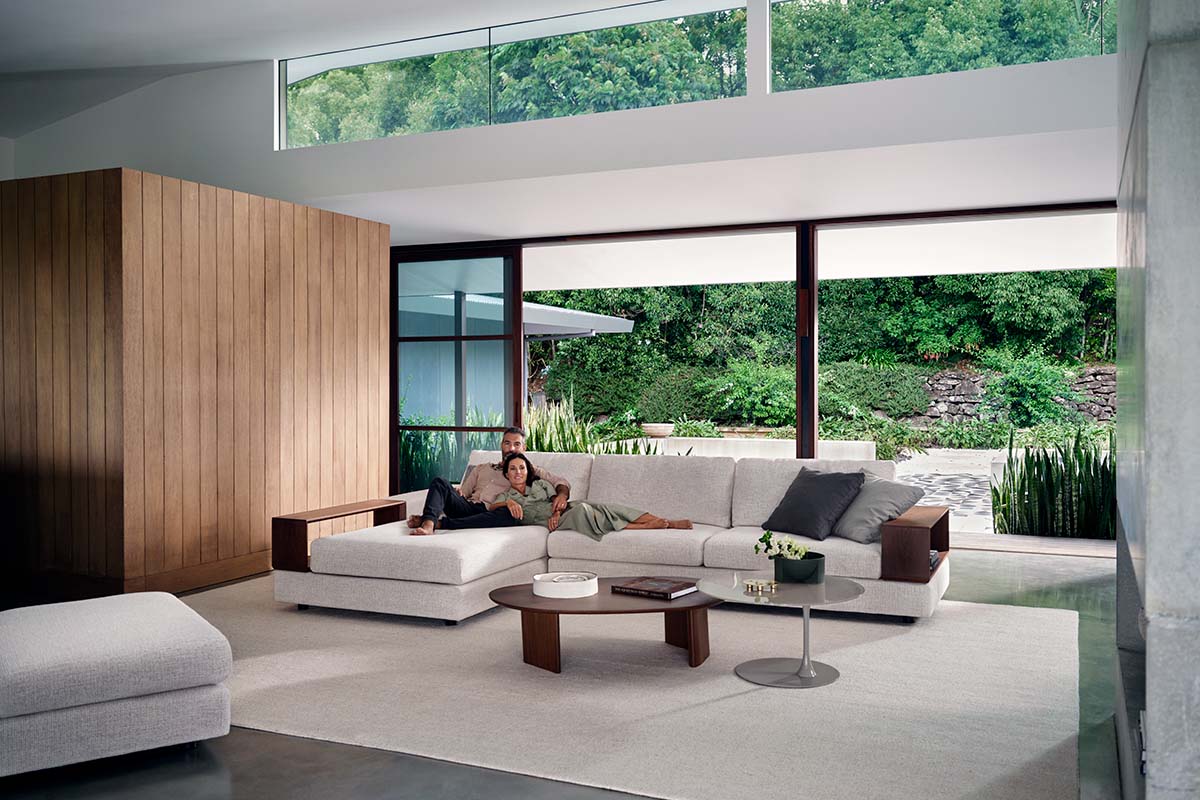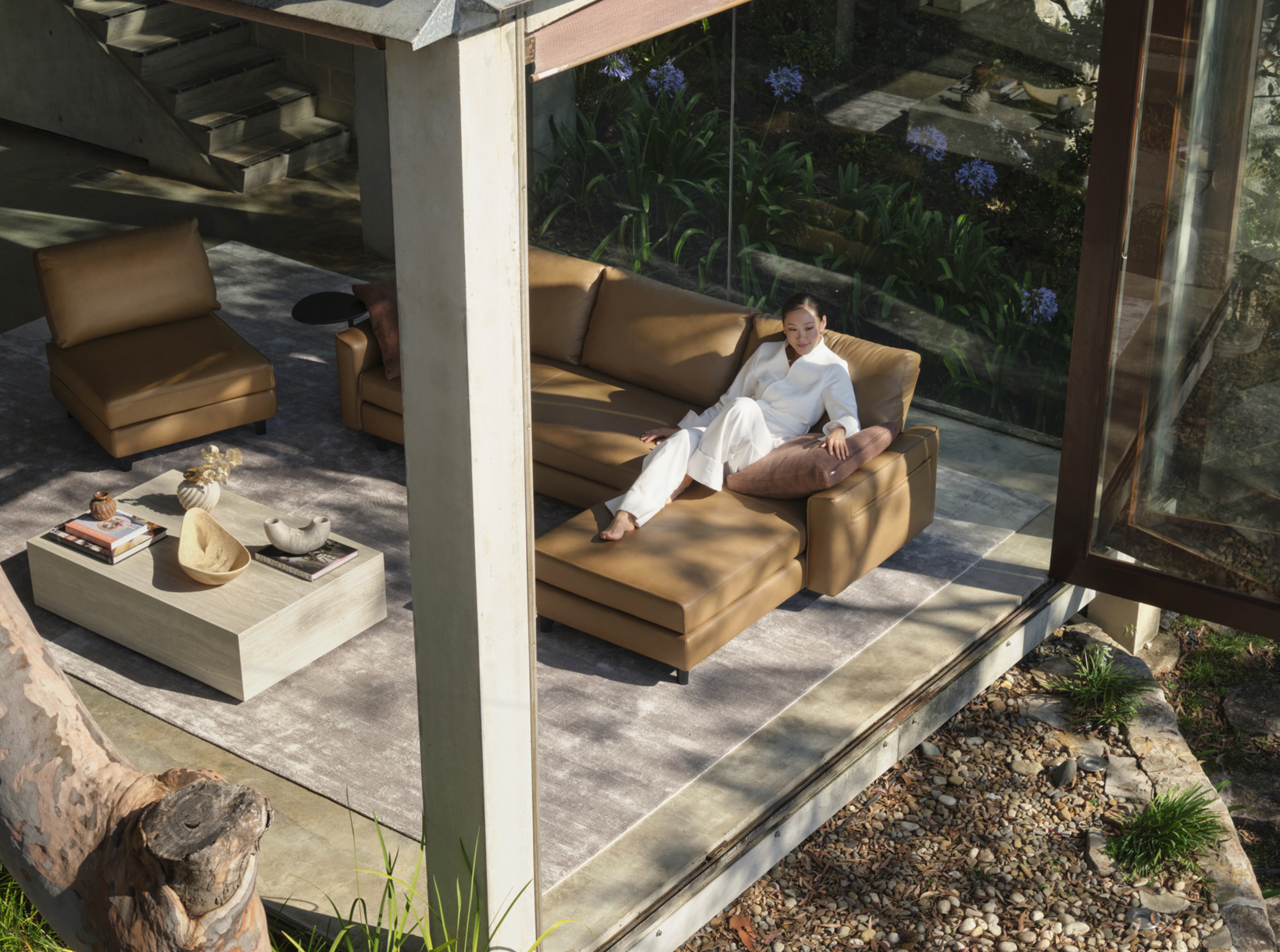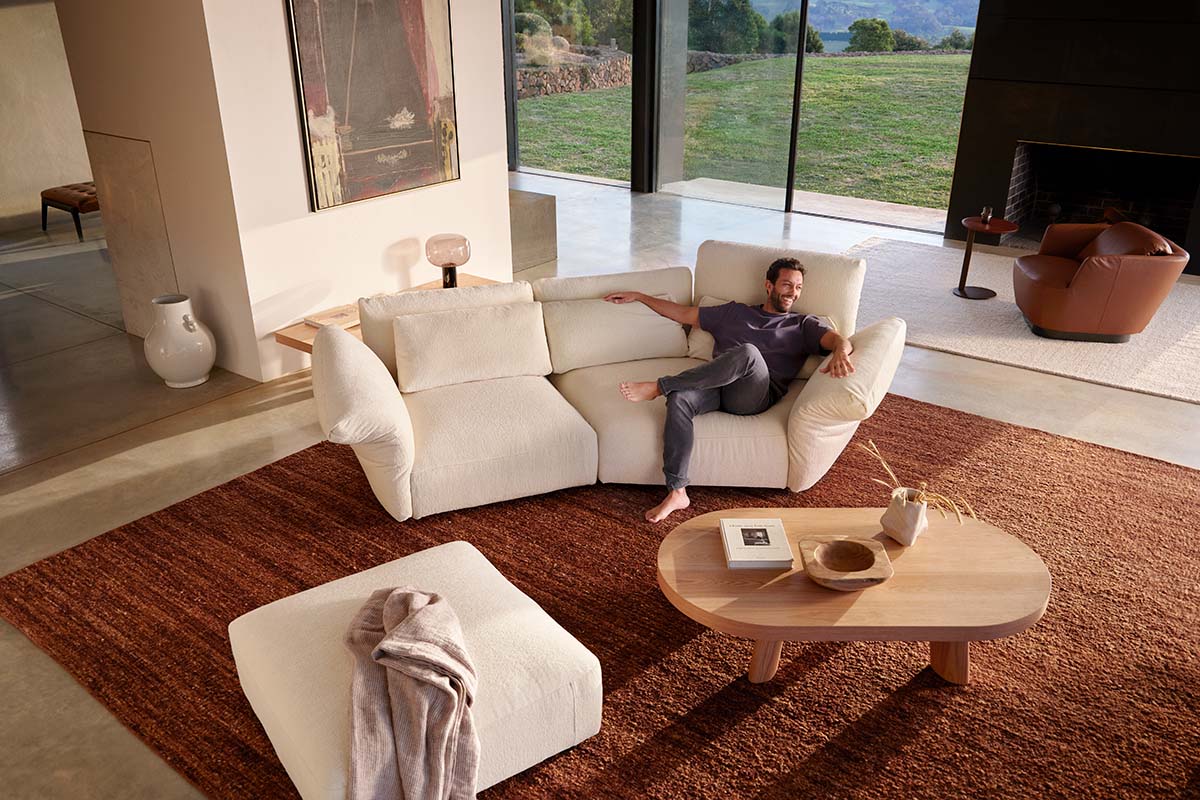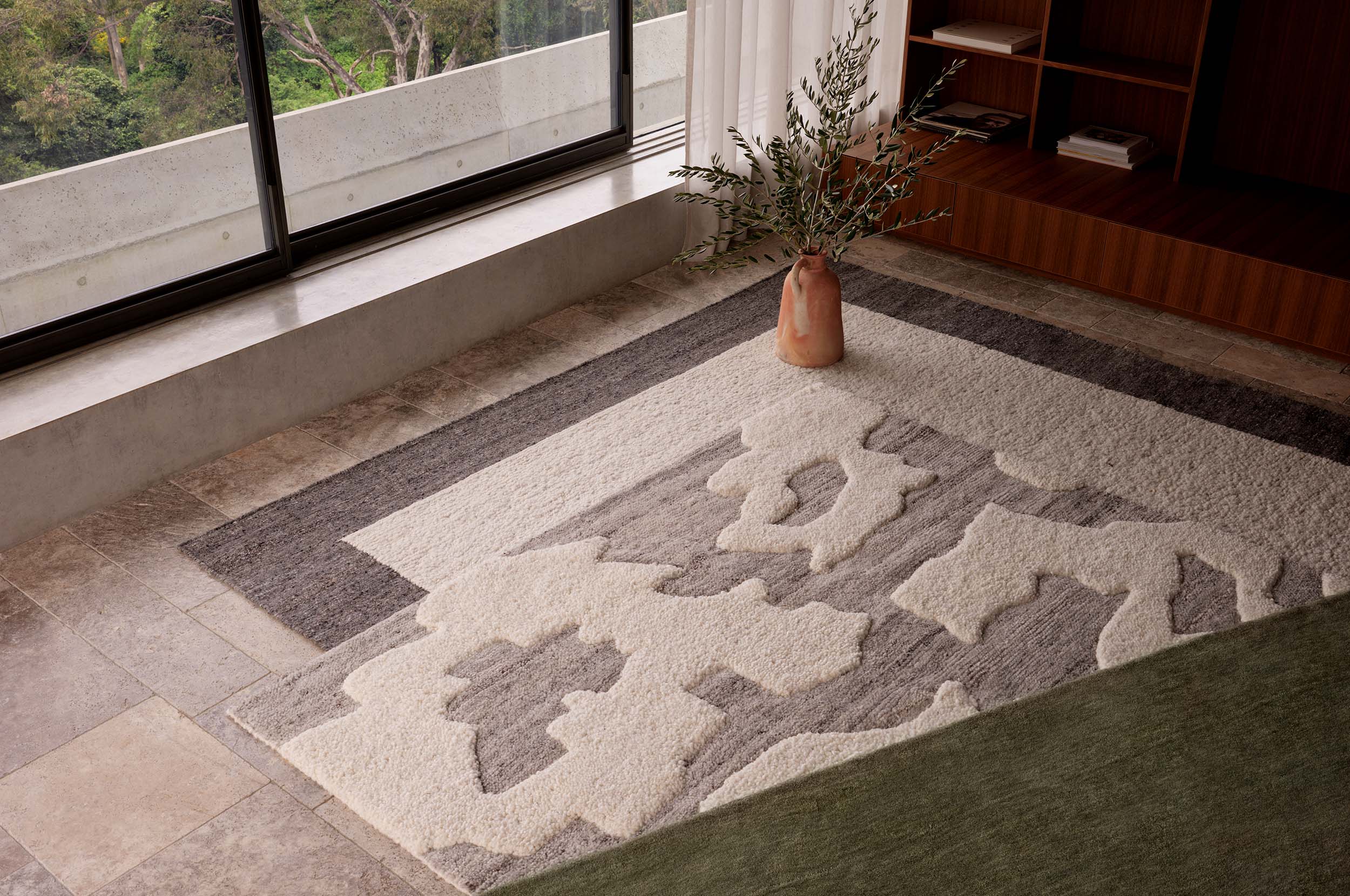
A rug doesn’t just frame a space, it defines it. When thoughtfully positioned and placed in a room, a rug creates cohesion, softens acoustics and protects the flooring beneath. The placement of a rug can shift the mood of a room, becoming a subtle yet integral element in shaping how a room feels and functions.
Designed to offer warmth, comfort, and longevity, King Living rugs are woven from considered materials. From handcrafted styles inspired by the natural world, to handloomed textures made with 100% recycled fibres, each rug balances sustainability and sophistication with refined patterns and luxurious softness.
This guide shares expert tips from King Living Senior Designer Alinta Lim on how to position a rug throughout the home, ensuring every placement adds character and complements the space.
What to consider before buying a rug
A rug has the power to anchor a space, soften it, and bring everything into balance.
"The floor sets the tone of a room. It’s a such large surface area yet often overlooked in its ability to shape how we respond to a space.” Alinta shares.
“When designing furniture, we take into consideration the spaces the furniture will sit within. Rugs are part of this environment and can often tie an interior together.”
But before choosing a style, it’s worth taking a moment to understand what your room needs.
Start with the dimensions. Measure the space carefully and consider how the rug will sit in relation to your furniture. Then, define the look you’re after. Do you want contrast or cohesion? Something understated, or a focal point that draws the eye?
Consider the texture underfoot, and how the rug will be used. Is it for a high-traffic area? Will it be partially covered by a sofa or coffee table? Do you want it to feel plush and comfortable, or more refined and structured?
Once you’ve defined the practical and aesthetic needs of the space, let your furniture guide the layout. Each room has its own rhythm, and here’s how to choose a rug that complements it.
Living room rug placement
The living room is the heart of the home: a place inviting connection, offering comfort and showcasing style. A rug helps define the space, often by framing a focal point — a coffee table or fireplace — to draw the eye and shape the flow of the room. Your rug also grounds the living space by anchoring the sofa.
When it comes to pairing your sofa with a rug, Alinta offers a key design tip. Oversize.
“A generously sized rug draws the room together, even in smaller living areas. Large rugs create the illusion of more floor space, meaning more balance and flow. A larger rug also gives every furniture piece room to belong.”
That’s why the first step to creating a harmonious living space is selecting a rug with the right proportions for your space.
Rug dimensions: How to choose the right size
-
Firstly, measure your sofa. If the space allows, invest in a large rug that can accommodate the sofa’s entire length. A well-proportioned rug should also extend beyond the width of your sofa, framing the seating arrangement and enhancing a sense of balance within the room. Once you know your sofa size, you’re set to choose the size of your rug.
-
When positioning the rug in your living room, allow it to sit at least 20–30 centimetres wider than the sofa on each side.
-
For the most spacious look, it’s best to leave 40 centimetres of floor space between the wall and a rug.
The King Living Rug Collection offers versatile sizing options to complement any layout: a standard 200 x 300cm, as well as larger dimensions of 260 x 360 and 300 x 430, with custom sizing available for select designs.
Discover our Rug Collection size comparison guide to help inform your decision with confidence.
Living room rug layout
Once the rug size is decided, begin to consider your furniture placement. There are three design approaches to consider:
- On the rug
Suitable for large rugs, placing all furniture on the rug creates a cohesive look in your living room, aesthetically connecting each of the elements. This is an ideal rug placement for a modular sofa, with the rug serving as a base for the seating arrangement
-
Partially on the rug
Placing only the front legs of the sofa on the rug draws other furniture such as your armchairs into closer alignment, establishing a layout that feels both intimate and relaxed. This considered approach enhances comfort without enclosing the space, making it particularly effective in larger living areas where a sense of warmth and connection is desired.
-
Off the rug
For smaller rugs or smaller living rooms, let the rug serve as a visual anchor by positioning your sofa and chairs around it rather than on top. In compact living rooms, your rug as the focal point creates a more open, airy feel, also providing the perfect setting to showcase a statement coffee table.
Rug styling for every sofa
If you have a modular or uniquely shaped sofa design, consider these design tips when selecting and placing your rug:
-
Three-seater sofas and modular designs: Selecting a larger 260 x 360 rug ensures the seating arrangement feels cohesive and grounded within the room.
-
Two-seater sofas: A 200 x 300 rug provides a balanced foundation, whether positioned fully beneath the sofa or allowing only the front legs to sit atop the rug.
-
Two sofas or a sofa with armchairs: A generously sized rug will unify the furniture, anchoring the conversation area and enhancing the flow of the space.
-
Sofas with a chaise: Select a rug large enough to encompass both the main seating area and the extended chaise, creating an elegant sense of continuity.
For those looking to introduce a sculptural touch, a round or organic rug can soften angular seating layouts.
“Styling a room with a round or organic rug is a simple way to create contrast without clutter,” Alinta shares.
“Contrasting the sculptural shape of your rug with the angular lines of furniture also naturally draws the eye.”
Style by positioning the front legs of your furniture just inside the curve of the rug or allow the rug to sit independently beneath a central feature, creating a striking, curated focal point.
Dining room rug placement
A rug in your dining room brings texture, colour, and frames the place where people gather: the dining table.
Whether you’re looking to create a formal dining setting for entertaining or a more intimate atmosphere for everyday family meals, your choice of rug will ground the setting and define the space. Beyond texture and colour, a well-chosen rug enhances the dining experience: softening acoustics and creating warmth.
Here are three considerations to make when choosing your dining room rug.
-
Shaping the setting
As a general design principle, your dining room rug should echo the shape and orientation of your dining table. Round rugs pair with round tables; rectangular rugs with rectangular tables. The rug should also be large enough to ensure the dining chair legs are still on the rug when pushed back.
“Everyone’s experienced a wobbly table or chair during dinner,” says Alinta, “it’s important your floor surface is level. Having both table and chairs on the rug is best so your dining experience isn’t disrupted.”
Centring your dining table on the rug is also best to keep your space looking balanced and offering guests a similar, comfortable experience.
-
Considering colour and texture
When choosing your rug, it’s important to consider the colour of your dining table and know how to complement it. King Living Dining Tables and chairs are made to order and customisable in signature timber finishes. Let’s explore how to style them:
-
For lighter finishes like Natural Oak, rugs in soft neutrals, warm beiges and pale greys, offer a fresh, clean and harmonious look. This balance is perfect for creating a relaxed, airy setting—ideal for casual family dining or bright, open-plan spaces.
-
Richer, warmer tones like American Walnut pair beautifully with muted earthy hues: taupe, soft charcoals, deeper creams and greens, that highlight the natural lustre of the timber. This duo offers an earthy warmth, both grounding and welcoming, suited to a versatile dining space that shifts between everyday meals and entertaining.
-
For the moodier timber finishes, Smoked Oak and Onyx, there are two refined styling approaches to consider. Curating with darker, tonal rugs in slate grey, deep charcoal or soft black add depth and sophistication, inspiring a formal or intimate dining atmosphere, perfect for evening meals. But layering deep timbers with lighter, neutral rugs alternatively lifts the palette. The dining room maintains a sense of openness with the neutral rug, while still looking refined—an effortless pairing for any occasion.
“Don’t shy away from a neutral rug,” shares Alinta, “some of the most inviting interior designs are grounded in neutrals. It’s the layering of tone, texture and material that brings a room to life.”
-
Prioritising practicality
Practical considerations are just as important when selecting the right colour for your dining room rug. Deeper colours and texture are a wise choice for the everyday, dining with children or dining around pets. Darker rugs help disguise spills or stains while maintaining an elegant aesthetic, offering you some time before cleaning your rug.
It’s also good to consider pile height when it comes to your dining room rug. A low-pile or flatweave rug allows chairs to glide smoothly, ensuring ease of movement during gatherings. High-pile rugs, while plush, can catch chair legs and disrupt the flow of the setting. These are often preferred in living spaces and bedrooms to add softness and comfort.
To preserve the beauty and longevity of your rug, consider using an anti-slip underlay, tailored to complement your King Living Rug. An anti-slip underlay can be added at the time of purchase and is a simple addition to prevent movement and bunching, keeping the rug firmly in place while adding a layer of cushioning underfoot.
Bedroom rug placement
“A bedroom rug is a quiet luxury. A rug beneath the bed enhances the way you move through the space, softening transitions and making the room feel personal.”
In a bedroom, a rug adds softness but also transforms your daily experience in the space, dampening the sound level and reducing echoes for a quieter, more restful night’s sleep. A bedroom rug also offers warmth underfoot on cooler mornings and a gentle surface to step onto at the start and end of each day.
When placing a rug in your bedroom, a good design tip to follow is ensuring that at least a third of the bed’s base sits on the rug. Size up if your space allows; a bed larger than the rug can create an imbalance in the room.
Here are three key guidelines to bedroom rug placement:
-
Bedside tables off the rug
For smaller rugs, position towards the foot of the bed, so that the bed sits partially on the rug. This ensures there is still warmth and softness beneath your feet while keeping the overall feel of your bedroom relaxed and spacious. Aim here for around 700mm between the side of the bed and the side of the rug.
-
All furniture on the rug
Positioning the bed and side tables fully on the rug creates a defined, cohesive section within the bedroom. This is perfect for dividing your bedroom into sections, separating your bed from your wardrobe, desk, or doorway. Similarly aim for a space of 700mm between the edges of the furniture to preserve a sense of proportion and openness.
-
Round rug placement for smaller bedrooms
A round rug brings a more relaxed, informal sensibility to the bedroom. Styled under one corner of the bed, this position is perfect for asymmetrical layouts where you might want to introduce pattern and vibrancy, but also for more compact bedrooms, where the bed is positioned against a wall.
Hallway rug placement
Hallways are often overlooked when it comes to rug placement. It’s important to consider the swing of the doors to ensure the rug doesn’t obstruct the doors from opening and closing freely.
If you have a console table or other furniture, it’s best for the furniture to sit either completely on or off the rug for a cohesive look.
Outdoor rug placement
Outdoor rug placement follows the same principles as indoor spaces. An Outdoor rug can bring considerable comfort to your outdoor area by providing a softer surface to walk on.
Outdoor furniture – like your living room – can be placed on the rug, partially on the rug or off the rug.
When selecting an Outdoor rug, it’s important to consider the rug material to ensure it is designed for longevity and to withstand the elements.
Organic rug placement
If you have an organic-shaped rug – like our Antipodes Organic Rug – you can follow these same guidelines for each room.
Organic-shaped rugs are a great option to creates a sense of calm with a natural shape while remaining boldly individual.
Shop the King Living Rug collection
The handcrafted collection of King Living Rugs combines texture, pattern and colour to create a luxuriously effortless range for every room in the home.
Shop the collection and use our rug placement guide to ensure the perfect positioning, every time.
For more articles on rugs, you can explore:
- The complete guide to buying the perfect rug
- Learn how to maintain and clean your rug
- Guide to wool rugs












